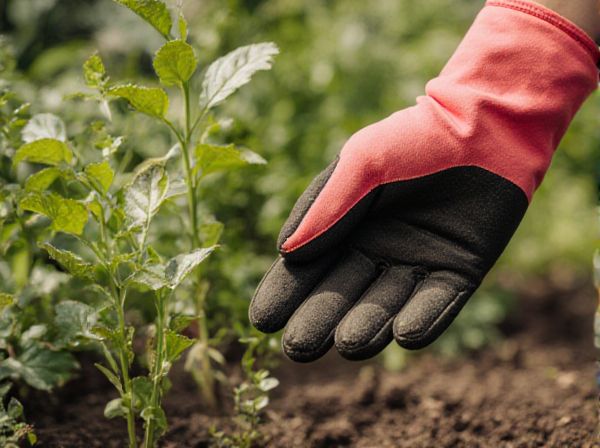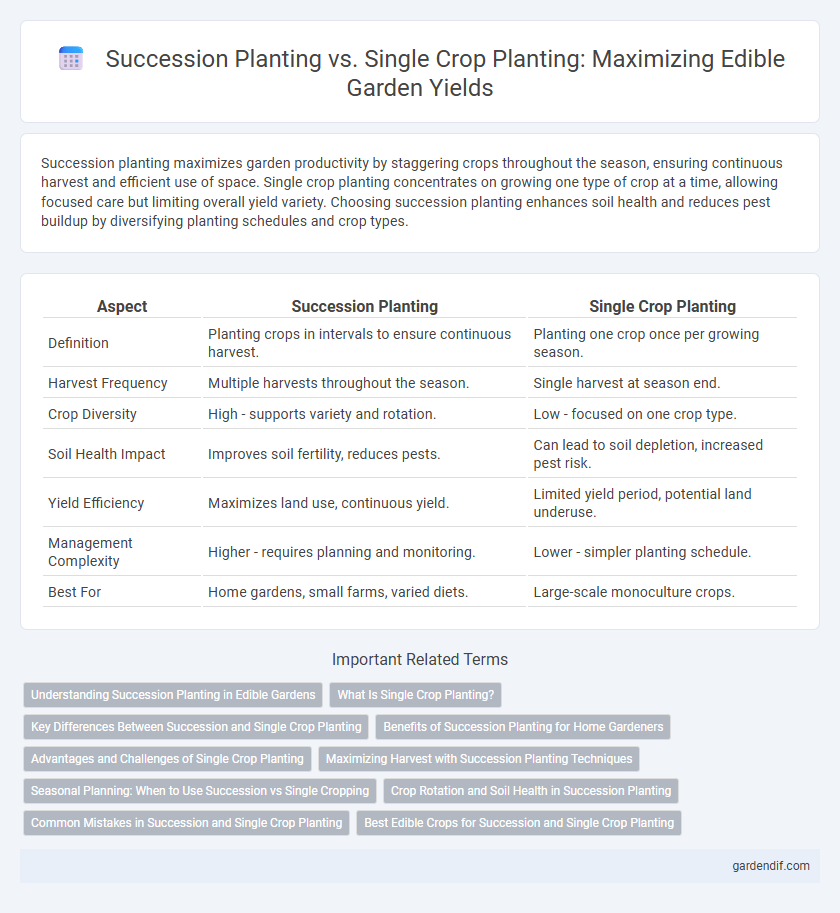
Succession planting vs Single crop planting Illustration
Succession planting maximizes garden productivity by staggering crops throughout the season, ensuring continuous harvest and efficient use of space. Single crop planting concentrates on growing one type of crop at a time, allowing focused care but limiting overall yield variety. Choosing succession planting enhances soil health and reduces pest buildup by diversifying planting schedules and crop types.
Table of Comparison
| Aspect | Succession Planting | Single Crop Planting |
|---|---|---|
| Definition | Planting crops in intervals to ensure continuous harvest. | Planting one crop once per growing season. |
| Harvest Frequency | Multiple harvests throughout the season. | Single harvest at season end. |
| Crop Diversity | High - supports variety and rotation. | Low - focused on one crop type. |
| Soil Health Impact | Improves soil fertility, reduces pests. | Can lead to soil depletion, increased pest risk. |
| Yield Efficiency | Maximizes land use, continuous yield. | Limited yield period, potential land underuse. |
| Management Complexity | Higher - requires planning and monitoring. | Lower - simpler planting schedule. |
| Best For | Home gardens, small farms, varied diets. | Large-scale monoculture crops. |
Understanding Succession Planting in Edible Gardens
Succession planting in edible gardens maximizes space by staggering crop planting times to ensure continuous harvests, unlike single crop planting which involves growing one crop at a time in a designated area. This method increases yield efficiency by rotating fast-maturing vegetables with slower-growing varieties, promoting soil health and reducing pest buildup. Understanding succession planting techniques such as intercropping and relay planting enhances productivity for gardeners seeking year-round fresh produce.
What Is Single Crop Planting?
Single crop planting involves cultivating one type of crop in a specific area during a growing season, maximizing space for that particular plant's growth requirements. This method simplifies pest management and nutrient allocation but may increase vulnerability to pests or diseases targeting that crop. Farmers often choose single crop planting for crops with uniform harvesting schedules and specific soil or climate needs.
Key Differences Between Succession and Single Crop Planting
Succession planting involves sowing crops in intervals to ensure continuous harvest, maximizing garden space and extending the growing season, while single crop planting focuses on growing one type of crop per season for concentrated yield. Succession planting requires careful timing and crop selection to avoid overlaps and nutrient depletion, whereas single crop planting simplifies pest and disease management due to mono-cropping. The choice impacts soil health, harvest frequency, and overall garden productivity, making succession planting ideal for high-yield diversity and single crop planting suited for commercial-scale uniformity.
Benefits of Succession Planting for Home Gardeners
Succession planting maximizes garden yield by allowing home gardeners to grow multiple crops in the same space throughout the season, optimizing limited garden areas. This technique reduces downtime after harvesting by immediately planting new seeds, leading to a continuous supply of fresh produce. It also helps manage risks of pest and disease outbreaks, promoting healthier plants and improving overall garden resilience.
Advantages and Challenges of Single Crop Planting
Single crop planting offers streamlined management and uniform crop care, which can lead to higher yields per acre due to focused nutrient and pest control. However, this method is vulnerable to pests and diseases that can rapidly spread through monocultures, increasing the risk of significant crop loss. Soil depletion and reduced biodiversity present additional challenges, often necessitating crop rotation or soil amendments to maintain long-term soil health.
Maximizing Harvest with Succession Planting Techniques
Succession planting maximizes harvest by staggering crop cycles, allowing continuous production and efficient use of garden space. This method adapts planting schedules based on specific crop growth rates and climate conditions, increasing yield over time compared to single crop planting. Employing techniques such as intercropping and rotating crops further enhances soil health and reduces pest buildup for sustained productivity.
Seasonal Planning: When to Use Succession vs Single Cropping
Succession planting maximizes seasonal yield by staggering crop cycles, ideal for fast-growing vegetables like lettuce and radishes during spring and fall. Single crop planting suits longer-season crops such as tomatoes and squash, benefiting from stable conditions in summer months. Effective seasonal planning balances crop maturity rates and climate patterns to optimize harvest timing and garden productivity.
Crop Rotation and Soil Health in Succession Planting
Succession planting enhances crop rotation by continuously cycling different plant families in the same area, reducing soil nutrient depletion and interrupting pest and disease cycles. This method maintains soil health by promoting diverse root structures and organic matter inputs, improving soil structure and microbial activity. In contrast, single crop planting often leads to soil exhaustion and increased vulnerability to pathogens due to repetitive nutrient demands and a lack of biodiversity.
Common Mistakes in Succession and Single Crop Planting
Common mistakes in succession planting include overcrowding and improper timing, which lead to poor crop yields and increased pest issues. Single crop planting errors often involve neglecting soil nutrient depletion and failing to rotate crops, causing soil degradation and increased disease susceptibility. Proper planning and understanding crop cycles are essential for maximizing productivity and maintaining soil health.
Best Edible Crops for Succession and Single Crop Planting
Succession planting maximizes yield by staggering harvests of fast-growing edible crops like lettuce, radishes, and spinach, ensuring continuous production throughout the season. Single crop planting is ideal for staple edibles such as tomatoes, corn, and potatoes, which require focused growth periods for optimal size and flavor. Selecting crops with complementary growth cycles and nutritional profiles enhances garden productivity and extends fresh harvest availability.
Succession planting vs Single crop planting Infographic

 gardendif.com
gardendif.com